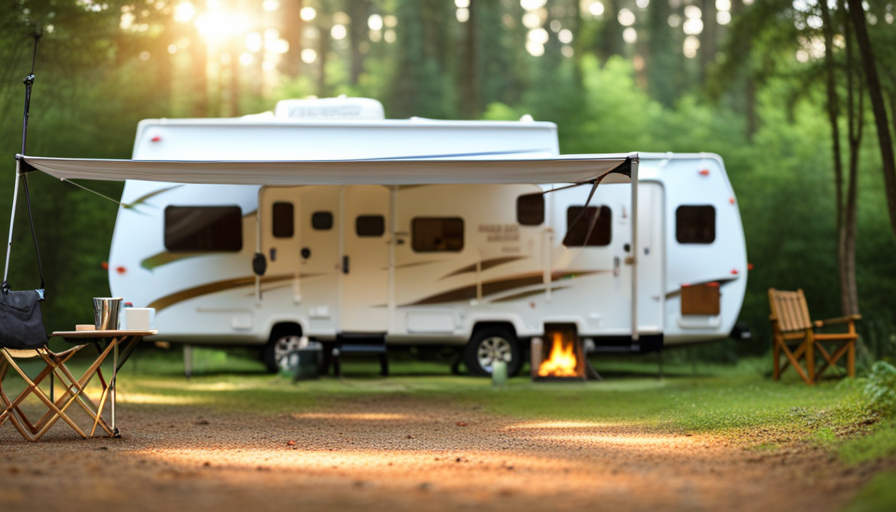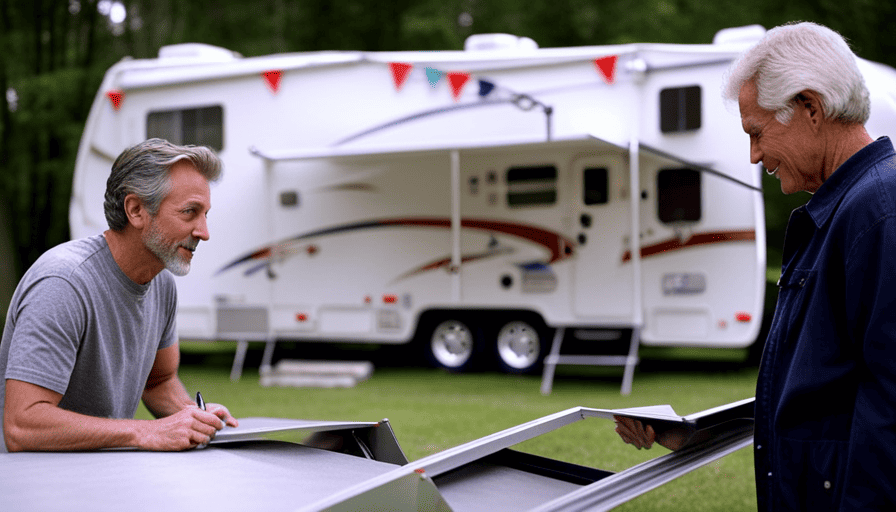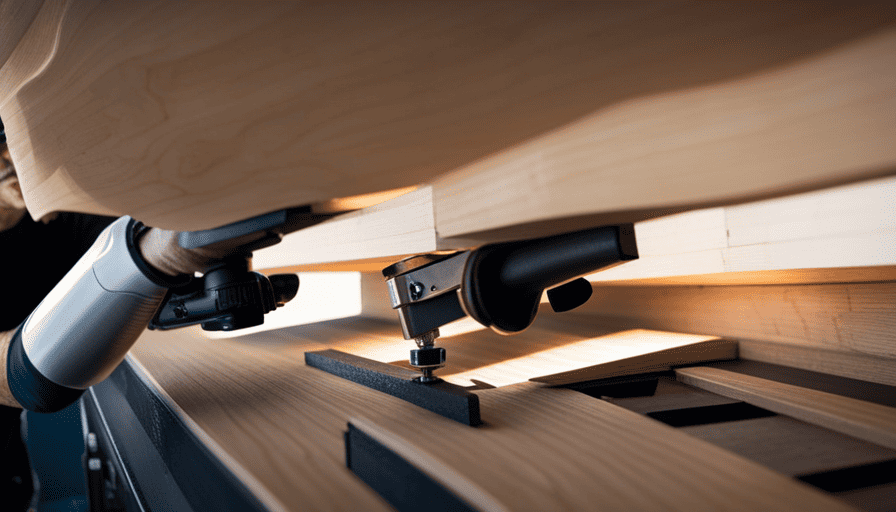Congratulations on deciding to embark on an exciting camping adventure with your reliable camper. Picture this: you are comfortably nestled in a tranquil forest, surrounded by the wonders of nature, and basking in the peaceful beauty of the expansive wilderness.
But wait, what’s that scurrying sound? Oh no, it’s mice! These tiny, unwelcome guests have found their way into your camper, threatening to turn your peaceful retreat into a rodent-infested nightmare.
But fear not, dear camper enthusiasts, for I am here to share with you my expertise on keeping those pesky critters at bay. In this article, I will guide you through practical and effective ways to keep mice out of your camper.
From identifying potential entry points and sealing cracks, to using repellents and storing your camping gear properly, I’ve got you covered.
So, let’s dive in and ensure that your camper remains a haven of tranquility, free from unwanted furry visitors.
Key Takeaways
- Identify and seal potential entry points for mice, such as wires, pipes, vents, gaps, and cracks.
- Use mouse repellents such as peppermint oil, mothballs, or electronic repellents to deter mice from entering the camper.
- Properly store food and trash in sealed containers to prevent attracting mice.
- Regularly clean and vacuum the camper to eliminate food sources, disrupt scent trails, and remove potential nesting materials.
Identify Potential Entry Points
Now, let’s take a look at where those sneaky mice might be trying to find their way into your camper. Identifying potential entry points is crucial in effectively preventing these unwanted critters from invading your space.
Mice are incredibly resourceful and can squeeze through even the tiniest openings. Start by thoroughly inspecting the exterior of your camper, paying close attention to areas where wires, pipes, or vents enter the vehicle. These are common entry points that mice can exploit. Additionally, check for any gaps or cracks in the walls, windows, and doors. Mice can easily slip through these openings and make their way inside.
To further protect your camper, make sure to seal any openings you find using materials like steel wool, caulk, or expanding foam. This will create a barrier that is impenetrable to mice.
By being thorough in identifying potential entry points and implementing effective prevention techniques, you can ensure that your camper remains mouse-free.
Moving on to the next section, let’s discuss how to seal cracks and holes to fortify your camper against these pesky intruders.
Seal Cracks and Holes
To prevent any unwelcome visitors, it’s crucial to patch up any cracks or holes in your camper, creating a fortress against unwanted intruders. Mice are small creatures that can squeeze through even the tiniest openings, so it’s important to be thorough in your sealing efforts.
There are various sealant options available, depending on the size and location of the cracks or holes. For smaller gaps, you can use silicone-based caulking or weatherstripping tape, which are easy to apply and provide a tight seal. For larger openings, you may need to use expanding foam sealant, which expands to fill the gaps and creates a barrier that mice cannot penetrate.
When sealing cracks and holes, it’s important to pay attention to areas such as windows, doors, vents, and utility openings. These are common entry points for mice. Additionally, check for any gaps around pipes, wires, and cables that enter your camper.
DIY sealing techniques can be cost-effective and efficient. By taking the time to inspect and repair any cracks or holes in your camper, you can significantly reduce the risk of mice finding their way inside.
To further enhance your defense against these pesky creatures, it’s important to also consider using mouse repellents. These repellents can be used in conjunction with sealing techniques to create an even more effective barrier against mice.
Use Mouse Repellents
When it comes to keeping mice out of a camper, there are a few key points to consider regarding mouse repellents.
Natural repellents, such as peppermint oil or mothballs, can be effective in deterring mice from entering your camper. These options are safe and easy to use, making them a practical choice for preventing mouse infestations.
Additionally, electronic repellents can be a great option, emitting ultrasonic sounds that are unpleasant to mice. These devices are low maintenance and can cover a larger area, making them a convenient choice for keeping mice away from your camper.
Natural Repellents
If you’re looking for a more natural approach, there’s a trick that might just keep those pesky mice away from your camper. Natural oils and homemade sprays can be effective in repelling mice.
Peppermint oil is a popular choice, as mice dislike its strong scent. Simply soak cotton balls in peppermint oil and place them strategically around your camper, focusing on entry points like windows and doors.
You can also make a homemade spray by mixing water and essential oils such as peppermint, lavender, or eucalyptus. Spray this mixture around your camper’s perimeter to create a barrier that mice will find unpleasant.
These natural repellents are safe to use and can be reapplied as needed. However, if you’re looking for a more advanced solution, electronic repellents might be the way to go.
Electronic Repellents
Electronic repellents, such as ultrasonic devices, can be a convenient option for deterring unwanted critters from infiltrating your RV. These devices emit high-frequency sound waves that are unbearable to pests like mice, rats, and even insects. The ultrasonic waves create a hostile environment for these creatures, causing them to flee in search of a more peaceful habitat.
What I love about electronic repellents is that they’re easy to install and require minimal maintenance. Simply plug them into an outlet, and they’ll start emitting sound waves that are inaudible to humans but effective in repelling pests. However, it’s important to note that electronic repellents may not work on all types of pests, and it’s always a good idea to use them in conjunction with other preventive measures, such as keeping food and trash secure.
By doing so, you can create a formidable defense against unwanted intruders in your camper.
Keep Food and Trash Secure
To prevent mice from invading your camper, it’s crucial to ensure that your food and trash are stored securely. Here are some discussion ideas to help keep your camper mouse-free:
-
Proper waste disposal: Mice are attracted to the smell of food and garbage, so it’s important to dispose of waste properly. Make sure to use sealed trash bags and place them in a designated garbage bin away from your camper. This will help deter mice from coming near your camping area.
-
Rodent-proof storage containers: Invest in durable, airtight containers to store your food. Mice can easily chew through plastic bags and cardboard boxes, so using rodent-proof containers is essential. Opt for containers with tight-fitting lids to keep the smell of food locked away and prevent mice from accessing it.
-
Clean up spills and crumbs: Mice are resourceful creatures that can survive on even the tiniest amounts of food. Therefore, it’s important to clean up any spills or crumbs immediately. Wipe down surfaces and sweep the floors regularly to eliminate any potential food sources for mice.
-
Keep food away from sleeping areas: Avoid storing food in your sleeping area or near your bed. Mice can easily detect the scent of food and will be more likely to venture into your camper if they know there’s a potential meal nearby.
-
Seal any entry points: Inspect your camper for any gaps or holes that mice can use to enter. Use silicone caulk or steel wool to seal these entry points and prevent mice from finding their way inside.
By following these tips, you can ensure that your food and trash are stored securely, minimizing the chances of mice invading your camper. Now, let’s move on to the next section about storing camping gear properly to further protect your camper from unwanted critters.
Store Camping Gear Properly
Make sure your camping gear is stored properly to protect it from potential damage and ensure that you can have a stress-free and enjoyable camping experience. Proper gear storage is essential to keep mice out of your camper.
When it comes to organizing camping equipment, there are a few key steps you can take to minimize the risk of mice infestation. Firstly, always clean your gear thoroughly before storing it. Mice are attracted to food crumbs, so make sure to remove any leftover food or spills.
Next, invest in airtight containers to store your gear. This will not only keep your items organized but also prevent mice from smelling any food residue. Additionally, consider using metal or plastic storage bins instead of cardboard boxes. Mice can easily chew through cardboard, so opt for more durable materials. Labeling your bins can also help you locate your gear easily and prevent unnecessary digging through your storage area.
Lastly, store your camping gear in a dry and elevated area. Moisture can attract mice, so make sure your storage location is well-ventilated and free from any leaks or condensation. By following these proper gear storage techniques, you can greatly reduce the chances of mice making their way into your camper.
Now, let’s move on to the next section about setting traps to keep mice out of your camper.
Set Traps
When it comes to setting traps to keep mice out of your camper, there are two main options to consider: humane traps and snap traps. Humane traps are a more ethical choice as they allow you to catch the mice without harming them, so you can release them back into the wild.
On the other hand, snap traps are a more traditional and effective option for eliminating mice, as they quickly and efficiently kill the rodents. Ultimately, the choice between these two types of traps will depend on your personal preferences and the severity of the mouse infestation.
Humane Traps
If you’re struggling with mice infestation in your camper, one effective solution is using humane traps, like the Havahart X-Small 2-Door Trap. These traps are designed to catch mice without causing harm to them.
Humane trap alternatives are a great option for those who want to avoid killing the mice. There are also various DIY mouse repellents that can be used in conjunction with these traps to increase their effectiveness. For example, peppermint oil and cotton balls can be placed near the traps to deter mice from entering the camper.
It’s important to remember that prevention is key when dealing with mice infestation, so sealing any potential entry points is crucial.
Once you have successfully captured the mice using humane traps, it is time to move on to snap traps for a more aggressive approach.
Snap Traps
Ready to tackle those pesky critters head-on? It’s time to unleash the power of snap traps in your battle against mice infestation!
Snap traps are a highly effective and practical method for getting rid of mice in your camper. When using snap traps, bait selection is crucial. Opt for enticing options such as peanut butter or cheese, which mice find irresistible. Place a small amount of bait on the trigger of the trap, making sure not to overload it.
Proper trap placement is also essential. Set the traps along walls or in areas where you’ve noticed mouse activity, ensuring that the trigger is facing the wall. This will increase the chances of the mice encountering the trap.
Once you’ve mastered the art of snap trapping, it’s important to regularly clean and vacuum your camper to prevent future infestations.
Regularly Clean and Vacuum
To effectively keep mice out of your camper, it’s important to regularly clean and vacuum. Regular maintenance is key in preventing pests from making your camper their home. Here are three reasons why cleaning and vacuuming should be a part of your routine:
-
Eliminate Food Sources: Mice are attracted to crumbs and food residue left behind. By thoroughly cleaning countertops, tables, and floors, you remove any potential food sources that might attract these unwanted visitors.
-
Remove Hiding Spots: Mice seek out dark and cluttered areas to build their nests. Regular vacuuming helps to eliminate hiding spots by removing dust, debris, and any potential nesting materials.
-
Disrupt Their Scent Trails: Mice leave behind pheromone trails as they navigate through your camper. By vacuuming regularly, you disrupt these trails and make it harder for mice to find their way back.
By incorporating regular cleaning and vacuuming into your camper maintenance routine, you can significantly reduce the chances of mice infestation. However, keeping your camper clean is just the first step. In the next section, we’ll discuss how to remove potential nesting materials to further deter these pesky rodents.
Remove Potential Nesting Materials
Make sure you’re regularly getting rid of any materials that mice could use to create nests in your camper. Preventing infestation starts with removing potential nesting materials.
Mice are resourceful creatures and will use anything they can find to build their nests. Check your camper regularly for any signs of nesting activity, such as chewed up paper or fabric. If you find any, remove it immediately.
Pay close attention to areas where mice are likely to hide, such as under furniture, inside cabinets, or in storage compartments. Keep these areas clean and free of clutter to discourage mice from making a home in your camper.
In addition to removing nesting materials, it’s important to block access points to prevent mice from getting inside your camper in the first place. Inspect the exterior of your camper for any gaps or openings that mice could squeeze through. Use steel wool or caulk to seal these openings. Pay special attention to areas around pipes, vents, and electrical wiring, as these are common entry points for mice.
By eliminating potential nesting materials and blocking access points, you can greatly reduce the chances of a mouse infestation in your camper.
If despite your efforts, you still have a mouse problem in your camper, don’t hesitate to seek professional help. There are pest control services that specialize in dealing with mice infestations in campers and RVs. They have the knowledge and expertise to effectively eliminate the problem and prevent it from recurring.
Seek Professional Help if Needed
If all else fails, don’t hesitate to call in the experts for a mouse invasion that’ll make your skin crawl. Seeking professional advice can be invaluable when dealing with a persistent mouse problem in your camper. These professionals have the knowledge and experience to effectively eliminate mice and prevent future infestations. They can assess your camper, identify potential entry points, and provide recommendations for sealing them off. Additionally, they may use advanced techniques and products that aren’t available to the general public.
In addition to seeking professional help, there are also several DIY methods for mouse prevention that you can try. These methods can complement the efforts of the professionals and help maintain a mouse-free camper. Here are a few ideas to consider:
-
Use peppermint oil: Mice are repelled by the strong scent of peppermint oil. Soak cotton balls in peppermint oil and place them in areas where mice are likely to enter, such as around doors and windows.
-
Seal cracks and openings: Inspect your camper thoroughly for any cracks or openings that mice can squeeze through. Use caulking or weatherstripping to seal these gaps and prevent mice from gaining access.
-
Keep food stored properly: Mice are attracted to food sources, so be sure to store all food in airtight containers. This won’t only deter mice but also prevent other pests from being attracted to your camper.
By seeking professional help and implementing these DIY methods, you can effectively keep mice out of your camper. Taking these preventive measures will ensure a mouse-free environment and allow you to enjoy your camping experience without any unwanted visitors. Now, let’s explore further steps to take in order to maintain a mouse-free camper.
Take Preventive Measures
To ensure a critter-free camping experience, it’s important to take proactive steps to safeguard your cozy camper. Preventing infestations and maintaining cleanliness are key to keeping mice out of your camper. Here are some practical tips to help you achieve this.
First and foremost, seal any potential entry points. Mice can squeeze through tiny gaps, so inspect your camper thoroughly and seal any holes or cracks with steel wool or caulk. Pay close attention to areas around pipes, vents, and windows.
Next, keep your camper clean and tidy. Mice are attracted to food crumbs and spills, so it’s essential to eliminate any food sources. Store all food in airtight containers and avoid leaving out open food or dirty dishes. Regularly sweep and vacuum the floors to remove any crumbs or debris.
Additionally, consider using natural deterrents to repel mice. Peppermint oil, for example, is known to be a natural repellent. Soak cotton balls in peppermint oil and place them around your camper to discourage mice from entering.
Lastly, be mindful of your surroundings. Camp in areas away from brush or tall grass, as these can provide hiding spots for mice. Trim any overhanging branches that could provide access to your camper.
By taking these preventive measures and maintaining cleanliness, you can greatly reduce the chances of a mouse infestation in your camper and enjoy a critter-free camping experience.
Frequently Asked Questions
What are some common signs that mice have already entered the camper?
Well, if you’re wondering whether those pesky critters have made their way into your camper, there are a couple of telltale signs to look out for.
One obvious clue is the presence of mouse droppings. These little pellets are usually found near food sources or in hidden corners.
Another sign is chewed wires. Mice love to gnaw on electrical wiring, so if you notice any frayed or damaged cords, it’s a clear indication of their presence.
Can mice chew through metal or other hard materials?
Yes, mice can chew through plastic materials. They have incredibly sharp teeth that allow them to gnaw through various substances, including plastic, rubber, and even wood. To prevent mice from entering a camper, it’s important to seal off any potential entry points. This can be done by inspecting the camper for any gaps or holes and using materials like steel wool or caulk to fill them. Additionally, keeping the camper clean and free of food sources will also discourage mice from coming inside.
How often should mouse repellents be applied?
Mouse repellents typically last for several weeks before needing to be reapplied. The duration can vary depending on the specific product and the environmental conditions. To choose the best mouse repellent, consider factors such as its effectiveness, safety, and ease of use.
Look for repellents that use ingredients known to be effective against mice, such as peppermint oil or ultrasonic sound waves. Reading reviews and consulting with professionals can also help in making an informed decision.
Are there any specific foods that attract mice more than others?
Certain foods can be more enticing to mice than others. They’re attracted to sweet and savory items like grains, nuts, and chocolate.
To prevent mice from entering a camper, it’s essential to eliminate any potential food sources. Store food in airtight containers and clean up any spills or crumbs immediately.
Additionally, sealing off any entry points and using mouse repellents can further deter these pests from entering your camper.
What are some potential health risks associated with mice infestation in a camper?
Potential diseases associated with mice infestation in a camper can pose serious health risks. These pesky critters can carry harmful pathogens like Hantavirus, Salmonella, and Leptospirosis.
To avoid falling victim to these illnesses, it’s crucial to take preventive measures. Seal any entry points, store food in airtight containers, and regularly clean your camper. Additionally, setting up traps and using natural deterrents like peppermint oil can help keep these disease carriers at bay.
Stay vigilant and protect yourself from these tiny health hazards.
Are the Methods for Keeping Bugs Out of a Camper Also Effective for Keeping Mice Out?
When it comes to keeping mice out of your camper, the same tips for bug prevention can be effective. Seal off entry points with silicone caulk, store food in airtight containers, and use peppermint oil or dryer sheets as natural deterrents. These methods can help keep both bugs and mice at bay.
Conclusion
In conclusion, keeping mice out of your camper is crucial to ensuring a pleasant and pest-free camping experience. By following the steps outlined in this article, you can effectively prevent these furry intruders from making your camper their new home.
Remember to keep food and trash secure, store camping gear properly, and regularly clean and vacuum to maintain a mouse-free environment. And if all else fails, don’t hesitate to seek professional help.
Happy camping, and may your camper always be mouse-free!










